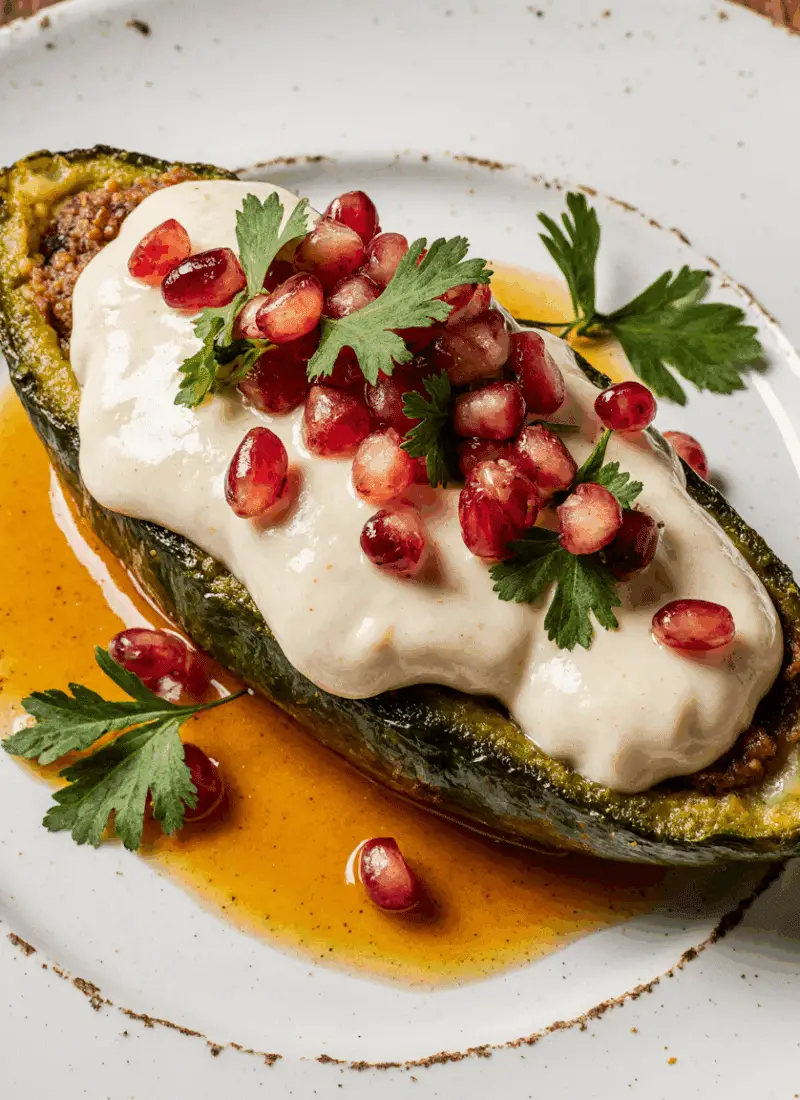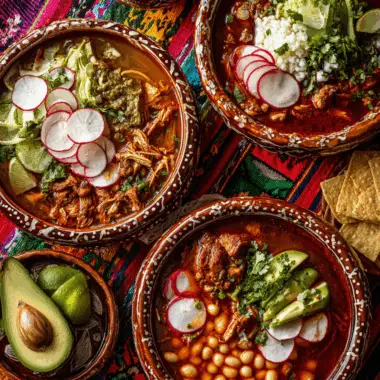Chiles en Nogada is a festive and traditional Mexican dish, celebrated especially on Mexican Independence Day. Originating from Puebla, this dish beautifully represents the Mexican flag with its green poblano peppers, white creamy walnut sauce, and red pomegranate seeds. Filled with a savory-sweet picadillo (ground meat mixture with fruits and spices), Chiles en Nogada combines complexity, elegance, and patriotism in every bite.
FULL RECIPE
Ingredients
1.For the Chiles and Filling:
- 6 large poblano peppers
- 2 tablespoons vegetable oil
- 1 small onion, finely chopped
- 2 cloves garlic, minced
- 500 grams (about 1 lb) ground pork (or a pork-beef mix)
- 2 tomatoes, peeled and finely chopped
- 1 apple (peeled and diced)
- 1 pear (peeled and diced)
- 1 ripe plantain or banana, diced
- 1/3 cup raisins
- 1/3 cup almonds, chopped
- 1/2 teaspoon ground cinnamon
- 1/4 teaspoon ground cloves
- Salt and pepper to taste
2.For the Nogada Sauce (Walnut Sauce):
- 1 cup shelled walnuts, soaked in milk for 4 hours and drained
- 1/2 cup milk (adjust for desired consistency)
- 1/2 cup Mexican crema or sour cream
- 100 grams (about 3.5 oz) cream cheese, softened
- 1 tablespoon sugar (optional, to taste)
- 1/2 teaspoon ground cinnamon (optional)
- Salt to taste
3.For Garnish:
- 1/2 cup pomegranate seeds
- Fresh parsley leaves, finely chopped
Directions
- Roast the Poblano Peppers: Place peppers directly over a flame or under the broiler, turning until all sides are charred. Transfer to a plastic bag or cover with a kitchen towel to steam for 10 minutes. Peel the skin off gently, make a slit lengthwise, and remove seeds. Set aside.
- Prepare the Filling: In a skillet, heat vegetable oil over medium heat. Sauté onion and garlic until translucent.
- Add the ground pork and cook until browned. Drain excess fat if necessary.
- Stir in chopped tomatoes and cook until softened.
- Add diced apple, pear, plantain, raisins, almonds, cinnamon, and cloves. Season with salt and pepper. Cook the mixture until fruits are tender and flavors meld, about 10–15 minutes. Let the filling cool slightly.
- Stuff the Peppers: Carefully fill each pepper with the cooled picadillo mixture. Fold the pepper closed and set seam-side down on a serving platter.
- Make the Nogada Sauce: In a blender, combine soaked walnuts, milk, crema, cream cheese, sugar, cinnamon, and salt. Blend until smooth and creamy. Adjust milk for a thinner consistency if desired.
- Assemble the Dish: Pour the walnut sauce generously over the stuffed peppers.
- Garnish: Sprinkle with pomegranate seeds and chopped parsley to represent the Mexican flag.
- Serve Chilled or at Room Temperature: Traditionally, Chiles en Nogada is served at room temperature, allowing the flavors to shine.
Nutrition Facts
- Calories: 520
- Protein: 22g
- Total Fat: 35g
- Saturated Fat: 12g
- Cholesterol: 80mg
- Carbohydrates: 30g
- Sugars: 14g
- Fiber: 6g
- Sodium: 450mg
- Vitamin C: 90% DV
- Calcium: 12% DV
- Iron: 18% DV
Nutritional Profile and Health Benefits
While Chiles en Nogada is a rich and indulgent dish, it also offers a variety of nutrients. The poblano peppers are high in vitamin C and antioxidants. The picadillo filling, typically made with lean ground pork or beef, provides protein, while the inclusion of apples, pears, and plantains adds fiber and essential vitamins like A and K. Walnuts are rich in healthy fats, particularly omega-3 fatty acids, which support heart health. Although the creamy sauce adds calories, when eaten in moderation, this dish can be part of a balanced celebratory meal.
Regional and Seasonal Variations
Although Puebla is the birthplace of Chiles en Nogada, regional variations of the dish have emerged across Mexico. Some versions use ground beef instead of pork, or mix the two. The choice of fruit can also vary based on seasonal availability—some cooks add peaches, apricots, or dried fruits. While traditionally served cold or at room temperature, in some areas it is enjoyed warm. The recipe is typically prepared in late summer when ingredients like walnuts and pomegranates are at their peak, which contributes to its seasonal exclusivity and festive association.
Sauce Texture and Flavor Adjustments
The walnut-based nogada sauce is a defining feature of the dish, and its texture can be customized. For a smoother sauce, walnuts can be blanched and peeled before blending, though some prefer a slightly coarse sauce for added texture. Sweetness levels vary by region and taste preference—some cooks include cinnamon, sugar, or even sherry for a sweeter profile, while others emphasize the natural creaminess and slight bitterness of the walnuts. The sauce can also be adjusted for thickness with milk or crema, depending on whether it’s being poured thickly or drizzled lightly.
Vegetarian and Vegan Modifications
Although the traditional recipe includes pork or beef, Chiles en Nogada can easily be adapted for vegetarian or vegan diets. The picadillo can be made using textured vegetable protein (TVP), mushrooms, or lentils as a protein substitute. For a vegan nogada sauce, plant-based alternatives like cashew cream or coconut yogurt can replace dairy ingredients such as cream and cheese. These versions retain the festive presentation and flavor complexity while offering a meat- and dairy-free option that fits modern dietary preferences.
Ideal Pairings and Complementary Dishes
Chiles en Nogada pairs well with simple side dishes that don’t compete with its bold flavors. Mexican-style white rice or esquites (street-style corn salad) are common accompaniments. The richness of the dish is best balanced with light drinks such as agua fresca (fruit-infused water), a dry white wine, or even a crisp Mexican lager. For dessert, something refreshing and citrusy like lime sorbet or mango slices helps cleanse the palate after the heavy sauce and meat filling.
Serving Tips for Presentation and Flavor
Presentation plays a huge role in the enjoyment of Chiles en Nogada. Traditionally, the dish is served on a white platter to emphasize the colors of the Mexican flag: green from the chile, white from the sauce, and red from the pomegranate seeds. To prevent the peppers from tearing, they should be carefully peeled and stuffed once cooled. The sauce should be poured just before serving to maintain its color and texture. Sprinkle the pomegranate seeds and parsley generously for visual contrast and patriotic flair.
Make-Ahead Tips and Meal Planning
Chiles en Nogada is a labor-intensive dish, but it can be prepared in stages to ease the process. The picadillo can be made a day in advance and stored in the refrigerator. Peppers can also be roasted, peeled, and stored until ready to be filled. Even the nogada sauce can be made ahead, although it’s best blended fresh to preserve the walnut flavor. Assembling the dish just before serving ensures the best texture and taste. This make-ahead strategy is ideal for large gatherings or holidays when kitchen time is limited.
Storage and Reheating Guidelines
Once assembled, Chiles en Nogada is best eaten within one day due to the delicate sauce and fresh garnishes. If storing leftovers, it’s best to keep the components separate: store the filled peppers and the nogada sauce in airtight containers in the refrigerator for up to three days. Reheat the stuffed peppers gently in the oven or microwave, then top with freshly blended sauce, pomegranate seeds, and parsley just before serving. Freezing is not recommended as the sauce can separate and the texture of the peppers may suffer.
Festive Significance and Modern Appeal
Despite its historical roots, Chiles en Nogada continues to appeal to modern food lovers for its bold fusion of sweet and savory flavors, dramatic presentation, and deep cultural relevance. It offers a taste of history in every bite, making it a meaningful addition to celebratory tables. Restaurants across Mexico and abroad serve this dish as a limited-time special, and food enthusiasts often take pride in preparing it at home. The dish stands out for its artistry and complexity, making it a culinary event in itself.
Conclusion
Chiles en Nogada is more than just a recipe it is a celebration of heritage, a showcase of culinary artistry, and a testament to the richness of Mexican tradition. From its patriotic symbolism to its intricate balance of flavors and textures, the dish brings people together around a shared love for culture and food.







